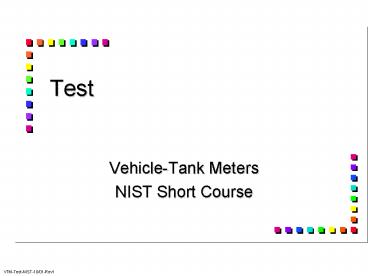Test - PowerPoint PPT Presentation
1 / 18
Title: Test
1
Test
- Vehicle-Tank Meters
- NIST Short Course
2
Testing - Overview
- Normal Test
- Slow-Flow Test
- Split Compartment Test
- RFI/EMI Test
- Automatic (Preset) Stop Test
- Antidrain Valve Test
- Review of Test Results
- Tests at or close to tolerances are repeated
3
Normal Test
- also known as fast test
- run at full flow with nozzle wide open
- verify flow rate does not exceed marked maximum
- basic tolerances apply
- assesses meter performance under normal conditions
4
Special Test - Slow Flow
- slow flow run just above minimum flow rate marked
on meter or 20 of max, whichever is lower - special test tolerances apply
- meter must be accurate at all points over rated
flow range - slow flow verifies accuracy at low end of flow
rate range - verifies proper maintenance of meter
5
Special Test - Vapor Elimination
- Split Compartment Test - Special Test
- designed to verify operation of air eliminator
- PD meter cannot distinguish between air and
product - vapor eliminator prevents air from entering meter
- performed on both multi- and single-compartment
vehicles
6
Vapor Elimination (cont.)
- 1) start from a compartment containing less
product than one-half capacity of prover - recommend starting test from largest compartment
- If starting with dry compartment, circulate some
product through system first. - 2) run product until lack of fluid causes meter
register to stop - 3) with pump in operation, shut manifold or
disconnect whip hose connection - 4) open valve from compartment with sufficient
supply of product to complete test
7
Set-up for Split Compartment Test
1. Start with a quantity of product equal
to less than 1/2 prover capacity in
largest compartment. Put enough product to
finish filling prover in other compartment.
150 to 200 gal product
150 to 200 gal product
Vehicle-Tank Truck
VTM-Test-NIST-08/01-Rev1
8
Set-up for Split Compartment Test
2. Pump product out of largest compartment into
prover until meter register stops.
150 to 200 gal product
(75 gal product pumped out)
largest compartment
75 gal product
smaller comp.
200 gal prover
Vehicle-Tank Truck
VTM-Test-NIST-08/01-Rev1
9
Set-up for Split Compartment Test
3. When meter register stops, have operator shut
manifold valve to large compartment open
manifold valve to compartment with product. Pump
product into prover until meter indication
reaches prover capacity. Disengage pump read
prover.
125 gal product
75 gal product
Vehicle-Tank Truck
200 gal prover
VTM-Test-NIST-08/01-Rev1
10
Vapor Elimination Test on Single Compartment
Vehicle
- test is run the same as for multi-compartment
vehicle except - pump is disengaged after fluid causes meter to
stop - duplicates what would happen in actual use
- prevents entrained air from splashing product
from being drawn into meter - product is added to empty tank
- pump is engaged again delivery continued to
completion
11
RFI/EMI Testing
- performed with equipment normally present in
environment - verifies equipment protected against effects of
RFI/EMI - some jurisdictions have specific procedures
- Scale Manufacturers Association (SMA) developed
RFI test procedure in 1970s - under revision
- developed for scales, but can be used as guideline
12
Automatic Stop Mechanism Test
- 1) set pre-set mechanism for pre-determined
quantity - not necessary to pump to capacity of prover
- pre-set quantity for at least 30 gallons
- 2) pump product into prover at full flow
- ensure smooth shut off within 1/2 minimum
increment - abrupt shut off can cause accelerated wear of
metering system
13
Anti-Drain Valve Test
- 1) at conclusion of last accuracy test, disengage
pump from vehicle engine - 2) raise length of discharge hose above meter
level - 3) open delivery hose valve over container
- 4) small amount of product will flow out
- flow should diminish and cease after about 30
seconds - if flow continues, anti-drain is malfunctioning
14
Reviewing Test Results
- Why run a slow test? Split-compartment test?
- tests designed to examine characteristics of
metering system - are metering system being properly maintained
- includes components such as air eliminator
- are adjustments being used properly
- are adjustments made to bring device as close to
zero error as possible - difference between results for tests at maximum
and minimum flow rates provides general
indication of condition of meter
15
(No Transcript)
16
Reviewing Test Results
- curve a is a new or recently adjusted meter
- curve b is a meter that is out of tolerance,
but that can be adjusted to bring entire curve
into tolerance band - curve c is a badly worn meter
- simply readjusting will not correct
- readjusting meter may bring the meter within
tolerance, but..remember G-UR.4.1. - equipment shall be continuously maintained in
proper operating condition - equipment in service at a single place of
business found to be in error predominantly in a
direction favorable to the device user shall not
be considered maintained in a proper operating
condition
17
Curve c Inside Tolerance Band-- Badly Worn
Meter
18
Completing Test
- review test results
- disconnect prover
- record ending totalizer readings and total
quantity dispensed during test - secure meter and prover
- apply appropriate seals to meter
- proceed to Post-Test Tasks
- assess official action required
- review results with owner
- explain test results, but dont troubleshoot































